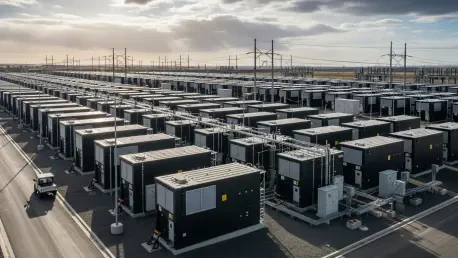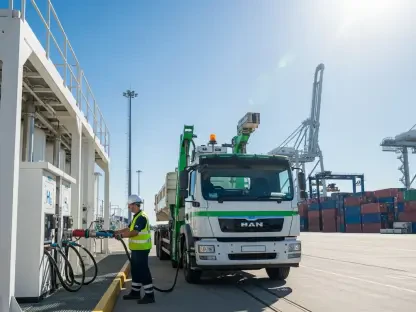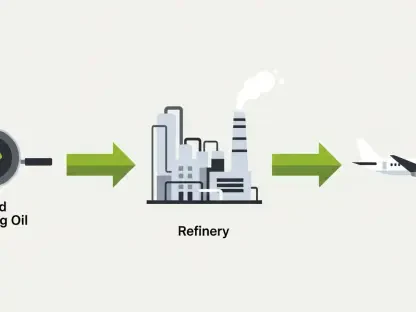Imagine a world where power outages are a rarity, even during peak demand or unpredictable weather, and renewable energy sources like wind and solar seamlessly meet the needs of millions without interruption. This vision is becoming reality with the rapid advancement of Battery Energy Storage Systems (BESS), a technology that stores and dispatches electricity to balance supply and demand. As utilities across the globe grapple with the challenges of integrating intermittent clean energy into aging grids, BESS emerges as a linchpin for stability and sustainability. This review delves into the core features, real-world performance, and transformative potential of BESS, spotlighting recent developments by Portland General Electric (PGE) in Oregon as a benchmark for industry progress.
Understanding the Core of BESS Technology
Battery Energy Storage Systems are engineered to capture electrical energy during periods of surplus and release it when demand spikes or supply dips, ensuring a steady flow of power. At their heart, these systems combine batteries, inverters, and sophisticated control mechanisms to manage energy efficiently. Their rise to prominence aligns with the global push for renewable energy adoption, as they mitigate the inconsistency of sources like solar and wind, which depend on weather conditions.
The significance of BESS extends beyond technical functionality; they represent a critical shift toward reducing reliance on fossil fuels. By storing clean energy for later use, these systems help utilities avoid firing up carbon-intensive backup generators during shortages. This dual role—enhancing grid reliability and supporting environmental goals—positions BESS as an indispensable tool in modern energy infrastructure.
Key Features and Performance Metrics
Dominance of Lithium-Ion Batteries
Central to most BESS deployments is lithium-ion battery technology, prized for its high energy density and efficiency. These batteries can store substantial amounts of power in a compact form, making them ideal for large-scale applications. Their scalability allows utilities to tailor storage capacity to specific needs, a factor evident in PGE’s projects, which boast a combined capacity of 492 MW across multiple sites in Oregon.
Performance metrics further underscore their value, with lithium-ion batteries offering thousands of charge-discharge cycles before significant degradation. While lifespan remains a concern—typically ranging from 10 to 15 years depending on usage—advancements in battery chemistry are steadily extending durability. Such characteristics make them a reliable choice for balancing grid demands over extended periods.
Energy Management and Control Systems
Equally vital to BESS functionality are the energy management and control systems that optimize performance. These sophisticated setups monitor grid conditions in real-time, directing when to store or release energy to prevent overloads or shortages. Their ability to respond swiftly to fluctuations ensures stability, particularly during peak usage hours or sudden drops in renewable generation.
A practical example lies in PGE’s integration of advanced control systems across its storage facilities. These systems not only manage energy dispatch but also help mitigate price volatility by reducing dependence on costly short-term electricity purchases. This strategic operation exemplifies how technology can align operational efficiency with economic benefits for utilities and consumers alike.
Industry Trends and Innovations
Recent years have witnessed remarkable strides in BESS technology, with innovations focusing on cost reduction and enhanced storage duration. Improvements in battery chemistry are paving the way for longer-lasting systems capable of supporting grids for extended periods without recharge. Simultaneously, declining costs are making large-scale deployments more accessible to utilities of varying sizes.
A notable trend is the increasing reliance on BESS for grid modernization, as seen in PGE’s expansion to 492 MW of storage capacity in Oregon. This leap from a mere 17 MW previously highlights a broader industry shift toward viewing storage as a core component rather than a supplementary asset. Such developments signal a maturing market ready to tackle the complexities of a renewable-heavy energy mix.
Collaboration is another defining trend, with public-private partnerships driving progress. PGE’s alliances with developers like Eolian and NextEra Energy Resources demonstrate how shared expertise and resources can accelerate deployment. These partnerships are setting a precedent for how utilities can leverage external innovation to meet ambitious energy goals.
Real-World Impact and Applications
The practical deployment of BESS reveals their transformative impact across diverse settings, particularly in utility operations. PGE’s projects—Seaside, Sundial, and Constable—strategically located at substations in North Portland, Troutdale, and Hillsboro, showcase how storage enhances grid reliability. With a combined 1.9 GWh of storage, these systems address load growth without necessitating expensive new transmission infrastructure.
Beyond reliability, BESS plays a pivotal role in balancing intermittent renewable energy. By storing excess power generated from wind and solar during off-peak times, these systems ensure availability during high-demand periods or when generation falters. This capability reduces the need for fossil fuel backups, aligning with broader sustainability objectives.
The economic advantages are equally compelling. By leveraging existing infrastructure at key substations, PGE’s initiatives minimize capital expenditure while maximizing efficiency. This approach not only supports the metropolitan energy needs but also serves as a model for other utilities seeking cost-effective solutions to modern grid challenges.
Challenges Hindering Wider Adoption
Despite their promise, BESS face technical hurdles that temper widespread adoption. Battery degradation over time remains a significant issue, as repeated cycling reduces capacity and efficiency. Additionally, current energy density limits the feasibility of longer-duration storage, a critical need for extended grid support during prolonged shortages.
Regulatory and market barriers further complicate deployment. Permitting processes can be lengthy and complex, delaying project timelines, while high upfront costs deter smaller utilities from investing. These financial constraints often require innovative funding models or policy incentives to bridge the gap between ambition and execution.
Efforts to address these challenges are underway, with research into alternative battery chemistries showing potential for greater durability and capacity. Meanwhile, policy frameworks are evolving to offer subsidies and streamlined approvals for storage projects. Overcoming these obstacles will be crucial to unlocking the full potential of BESS in the energy sector.
Looking Ahead: The Future of BESS
The trajectory of Battery Energy Storage Systems points toward broader adoption driven by anticipated technological breakthroughs. Innovations in solid-state batteries and other emerging chemistries could significantly enhance energy density and lifespan, addressing current limitations. Coupled with projected cost declines, these advancements may democratize access to storage solutions over the next few years, from 2025 onward.
The long-term impact on the energy landscape could be profound, enabling grids powered entirely by renewables. By providing a reliable buffer against supply variability, BESS can enhance energy security and resilience against disruptions. This vision of a sustainable grid hinges on continued investment in research and infrastructure to scale up deployment.
PGE’s model offers a blueprint for other utilities, demonstrating how strategic siting and partnerships can maximize impact. As more regions adopt similar approaches, BESS could shape national energy strategies, fostering a transition to cleaner, more dependable power systems. The industry stands at a pivotal moment, with storage poised to redefine how energy is managed and delivered.
Final Thoughts on BESS Evolution
Reflecting on the journey of Battery Energy Storage Systems, it becomes clear that their integration marks a turning point for grid reliability and renewable energy adoption. PGE’s ambitious expansion in Oregon stands as a testament to the technology’s capacity to transform utility operations, balancing economic and environmental priorities with remarkable efficiency. The challenges of degradation and cost, though significant, are being met with ongoing innovation and determination.
Looking back, the actionable path forward involves accelerating research into advanced battery technologies to overcome existing limitations. Policymakers must prioritize incentives and streamlined regulations to encourage adoption, while utilities need to explore collaborative models akin to PGE’s partnerships. The future demands a collective effort to scale these systems, ensuring they become the backbone of a resilient, sustainable energy ecosystem for generations to come.









